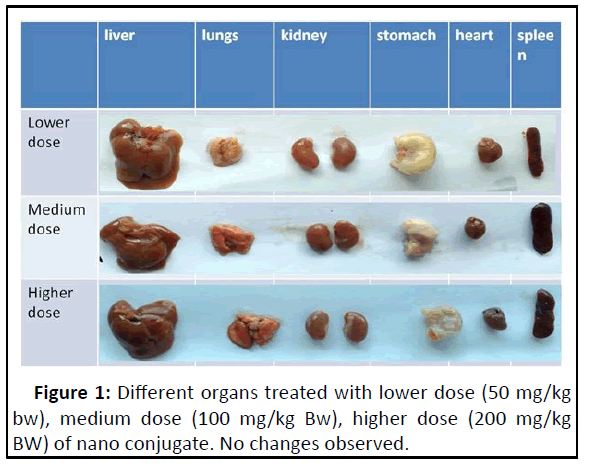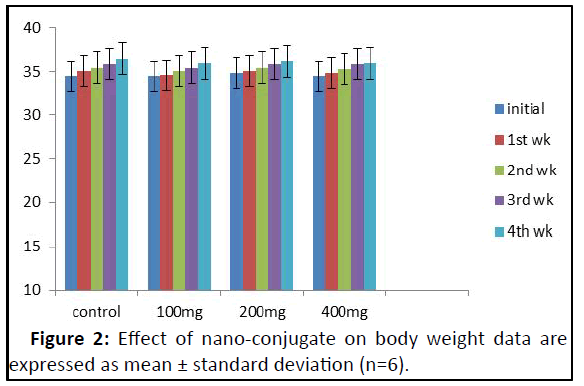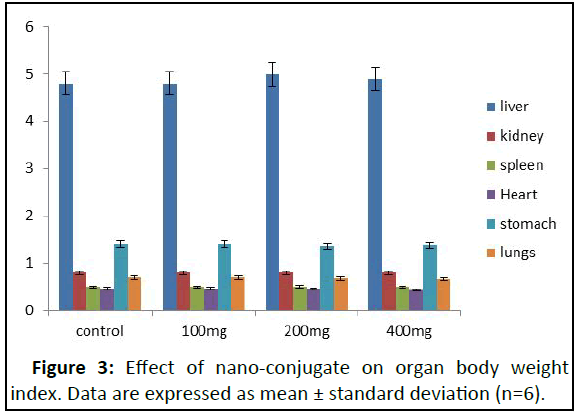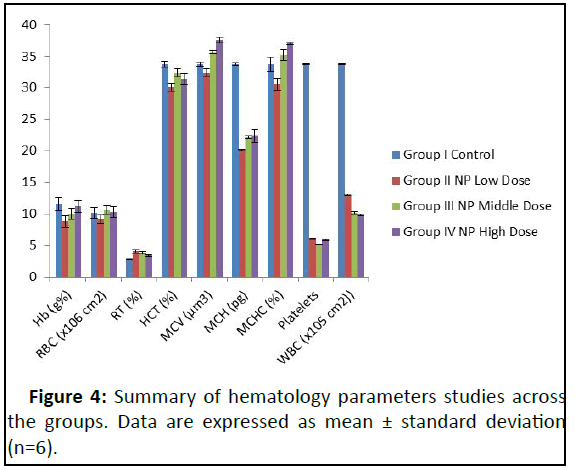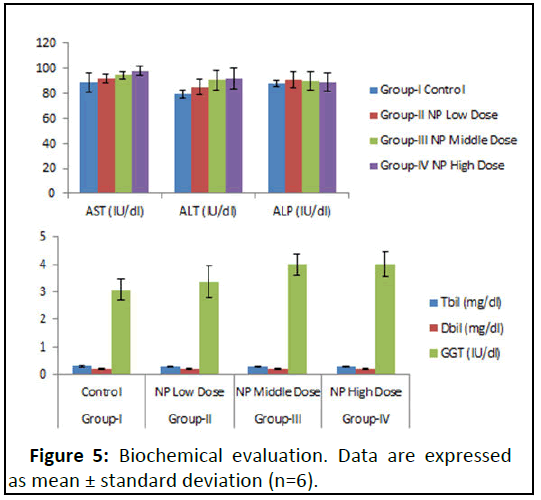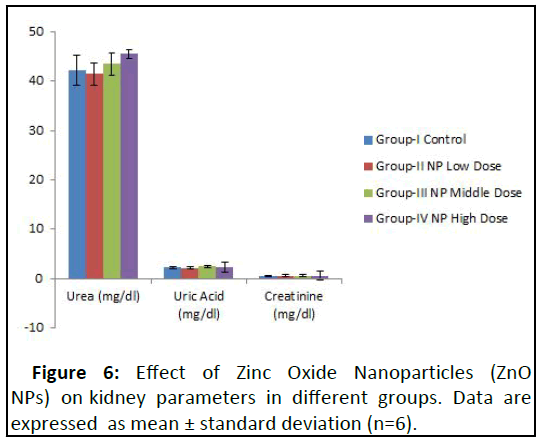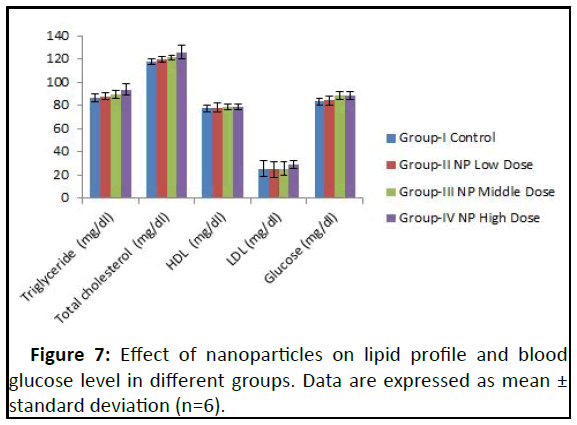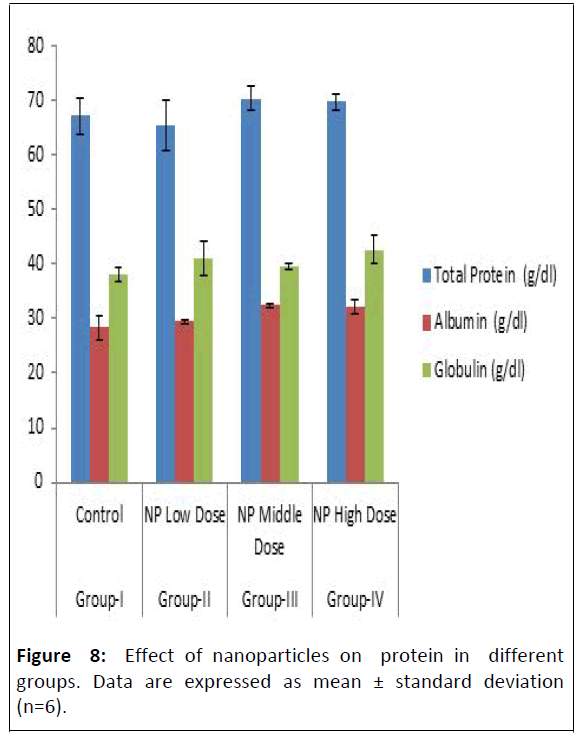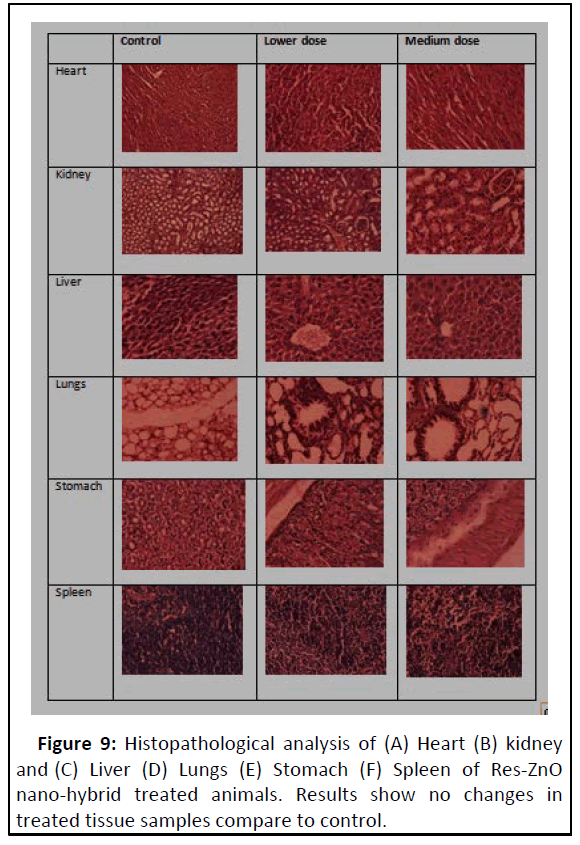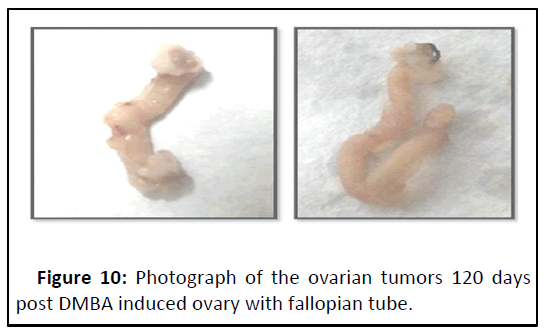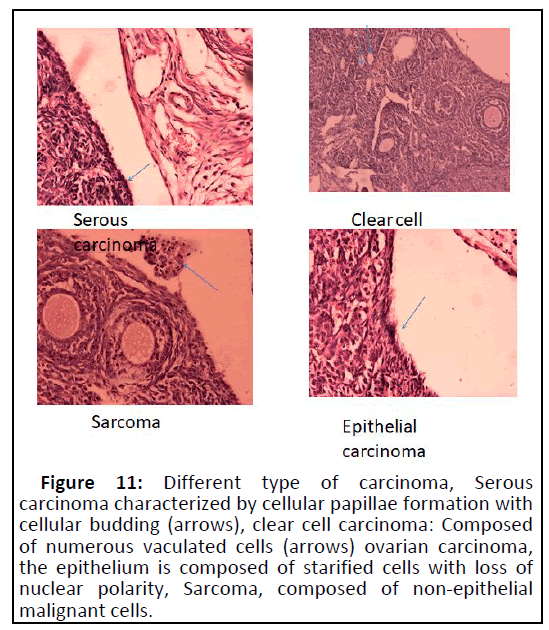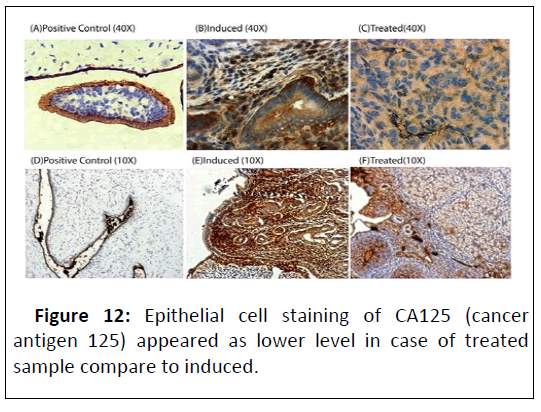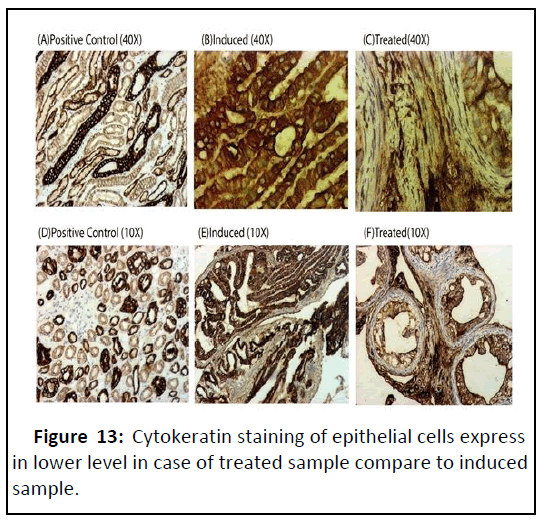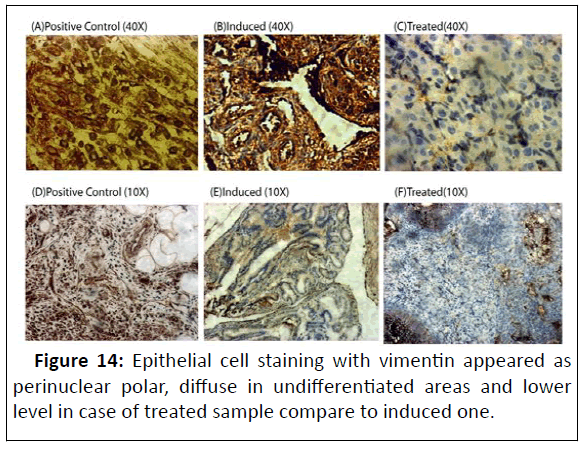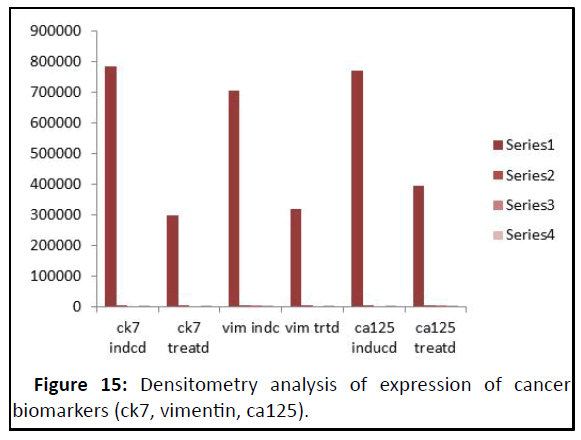Sanative Effect of Resveratrol-ZnO Nano-conjugate in DMBA Induced Ovarian Cancer in Murine Model
Soumendra Darbarb*, Ritwik Maity, Santasree Mazumder and Mahamuda Khatun
Department of Biochemistry, Ballygunge Science College, University of Calcutta, Kolkata, India
- *Corresponding Author:
- Soumendra Darbarb
Department of Biochemistry,
Ballygunge Science College,
University of Calcutta,
Kolkata, India,
Tel: 09477153353;
E-mail: dr.soumendradarbar@deysmedical.com
Received date: January 02, 2023, Manuscript No. IPAPP-23-15574; Editor assigned date: January 05, 2023, PreQC No. IPAPP-23-15574 (PQ); Reviewed date: January 20, 2023, QC No. IPAPP-23-15574; Revised date: March 23, 2023, Manuscript No. IPAPP-23-15574 (R); Published date: March 31, 2023, DOI: 10.36648/2393-8862.10
Citation: Darbarb S, Maity R, Mazumder S, Khatun M (2023) Sanative Effect of Resveratrol-ZnO Nano-conjugate in DMBA Induced Ovarian Cancer in Murine Model. Am J Pharmacol Pharmacother Vol:10 No:2
Abstract
Background: Resveratrol (3, 5, 4-trihydroxy-transstilbene), a natural phytoalexin is well known for its anticancer and chemo-preventive effect. To overcome stability and solubility issue of Resveratrol (RSV), a conjugation of RSV with ZnO nanoparticles was prepared to improve the efficacy and reduce the toxicity. Thus objective of the present study was to evaluate the potential effect of RSVZnO nano-conjugate in DMBA induced ovarian cancer in a defined rat model.
The acute and sub-acute toxicity was carried as per OECD guidelines 423 and 407, respectively. In the acute toxicity study, nano-conjugate drug was administered via single Intra Peritoneal (IP) injection at 200 mg/kg and 400 mg/kg bw doses in female albino wistar rats while in sub-acute toxicity study, female wistar rats was administered daily IP injection of 50 mg/kg, 100 mg/kg, 200 mg/kg body weight for 28 days. At the end of the study, the animals were sacrificed and effect of RSV-ZnO nano-drug on body and organ weight and hematological biochemical parameters and histopathological findings was evaluated. DMBA was used as inducing agent to develop ovarian cancer. Rats were treated by DMBA (50 mg/kg bw) via IP route once a week upto 3 week and kept animals for 3 months for development and progression of carcinogenesis in ovary. After 3 months, we treated the induced animals by RSV-ZnO nano-conjugate in three different doses (50 mg/kg, 100 mg/kg, and 150 mg/kg bw by IP) weekly for one month. After that, we sacrificed the animals and taken out the ovaries for histopathology for tumour subtyping and immunohistochemistry to evaluate the markers such as CA125, CK7, vimentin. RSV-ZnO nano-conjugate showed significant reduction of expression of cancer bio-markers and size of tumour. Besides, in acute and sub-acute toxicity study, it exhibited no untoward effects in animals.
Conclusion: The findings demonstrated that resveratrol ZnO nano-conjugate drug is safe and may be used for the treatment of ovarian cancer causing more efficacy and less toxicities.
Keywords
Safety study of the nano drug; Ovarian cancer induction by DMBA; Histopathological ananlysis; Immunohistochemistry; CA125; CK7; Vimentin cancer biomarker
Introduction
Ovarian cancer is one of the leading causes of cancer related deaths among women [1]. Effective detection and treatment of ovarian cancer remains a significant clinical challenge. Approximately 90% of ovarian tumors derive from an epithelial origin, most often considered to be the ovarian surface epithelium; 80% of these originated in the ovarian surface epithelium [2]. Incessant ovulation, postmenopausal increase of gonadotropin hormone levels, chronic inflammation and environmental carcinogens are assumed to play a key role in ovarian carcinogenesis [3]. When identified as stage I disease, 5 year disease free survival approaches 95%, although 20% of these patients will eventually relapse to a treatment failure overall. In early stage ovarian tumors lack specific clinical symptoms, which hampering early detection and delaying diagnosis in some cases [4]. Recent use of lysophosphatidic acid and the a-folate receptor as biomarkers, in combination with CA125, have improved the specificity for detection of early stage malignant gynecologic tumors, and will probably be further advanced by the addition of proteomic screening of low molecular weight serum proteins using Surface Enhanced Laser Desorption and Ionization Time Off Light (SELDI-TOF) mass spectroscopy. Incidence of ovarian adenocarcinoma has varied between 10% and 45%, perhaps, owing to the strain of rat employed or the chemical form of the DMBA utilized and the fact that different studies have observed a wide variance in the incidence of tumors of stromal origin [5]. To prevent or reverse the progression of initiated cells to malignant disease chemoprevention is an alternative approach. Clinical trials of preventive agents have demonstrated an efficacy in patients at risk for both breast and colon cancer. The first prevention trials for women shows high risk for the development of ovarian cancer and hence prophylactic oophorectomy have now been initiated to evaluate biomarker modulation e.g. ovarian surface metaplasia, cellular atypia and cortical inclusion cysts following short term treatment with fenretinide, oral contraceptive therapy or placebo [6].
Spontaneous rodent ovarian tumors of epithelial origin have been reported but these do not appear to occur in experimentally significant numbers [7]. Ovarian cancers are divided into type I or type II by histologically and genetically. Type I cancers are of low histological grade such as endometrioid, mucinous, and clear-cell carcinomas. Type II cancers are of higher histological grade and include serous carcinoma and carcino sarcoma [8]. Treatment of ovarian cancer are still not clear, there is a continuing need for a validated animal model possessing histological characteristics appropriate to the presentation of human ovarian tumors to evaluate the efficacy of newly developed chemo preventive compounds. 7,12-Dimethylbanz (a) Anthracene (DMBA) is a well-known polycyclic aromatic carcinogen that is capable of inducing the initiation, promotion and progression of tumor Importantly the histological type of experimental ovarian tumors may vary based on the animal strain used, use of carcinogen and age of animals. Use of carcinogen means amount and route of administration and method of induction. So, treatment and effective detection of ovarian cancer still a significant clinical challenge. The direct implantation of chemical carcinogen DMBA in the rat ovary leads to the induction of ovarian tumors at an incidence of 37%. These include adenocarcinomas, as well as stroma and mesothelial tumors [9]. There is however, lack of information regarding the sequence and nature of events elicited by DMBA and leading to ovarian cancer development. To improve its usage and physiologic relevance to the human disease, the DMBA model of ovarian cancer was modified by significantly decreasing the DMBA dose, thereby preserving maximally the integrity of the organ and by incorporating multiple gonadotropin hormone treatments, thus introducing an additional risk factor associated with human ovarian cancer, known also to induce hyper ovulation and enhanced mitogenesis of the ovarian surface epithelium [10].
Nanomaterial toxicity is a matter of concern and many in vivo studies have suggested that the surface chemistry, release of metal ion, Reactive Oxygen Species (ROS) production, cell apoptosis and break down of nano materials are the possible causes of cellular toxicity [11]. Current problem for nano medicine involve understanding the issue related to toxicity, in chemotherapy, toxicity to healthy cell is associated with anticancer drugs. Nanoparticles are used as a drug carrier for the specific delivery of drugs to cancer cells because of the size of nanoparticles which is similar to that of most biological molecules and structures. Consequently nanoparticles can be useful for both in vivo and in vitro biomedical application and research. The anticancer drug is delivered specifically to the cancer cells in targeted drug delivery. This reduces the toxicity to normal cells. The physicochemical characteristics of nano carriers, such as composition, particle size, surface charge, and the presence of ligands on their surface, will dictate their biodistribution and pharmacokinetics [12]. Nanoparticle to be used as a carrier in drug delivery system should be nontoxic in vivo. Surface modification and nano conjugation of nanoparticle with drugs is an aspect of drug delivery system design for biomedical applications. Modulation of nanoparticle by conjugation with drugs can influence particle uptake, biological responses, biodistribution and its efficacy also. Surface functionalization can be utilized to increase the drug circulation time in blood, reduce non-specific distribution or specific targeting of tissue or cells by using a targeting ligands [13].
In vivo, nanoparticles will be entrapped in and trans located to other tissues or organs along the blood circulation. The small size and large surface area equip them with an active group or intrinsic toxicity. Even at a very small cellular level, they may constitute potential long-term health hazards [14]. Toxicity indicates the disadvantageous effects due to the interaction between nano materials and cells. This interaction may differ depending on the chemical properties of the toxicants and the cell membrane, as it may take place on the cell surface or within the cell body. The evaluation of toxic properties of nano materials is pivotal when considering them for use in biomedical science. In practice, the evaluation typically includes acute, sub chronic, and chronic studies [15]. The current status of toxicology due to nanoparticles has been reported by Becker. Toxicity of Nps has been evaluated in different biological systems, such as bacteria, mammalian cells and in vivo model.
The safeties of RSV are well known, but the combined effects of this nano conjugate are unclear. Thus, it becomes essentials to evaluate the safety and toxicity of the conjugate, before their use. Therefore the objective of the present study, to assess the safety of nano conjugate by acute and sub-acute toxicity of nano conjugate in wistar rats, the study was done on the report of the Organization for Economic Co-operation and Development (OECD) guidelines 423 and 407 respectively [16].
After completing the safety study we evaluate characterization of ovarian tissue by two different study of this modified animal model. One is Induction of ovarian cancer by IP dosage of DMBA and another is treatment of ovarian carcinoma by RSV-ZnO nano conjugate drug (100 mg/wk for 3 weeks) with the immune histo chemistry study of some cancer biomarker such as CA125, vimentin and CK7. Cancer induction method by using DMBA is well established method but in this study we used IP injecton of DMBA with particular dose as an induction method which is very easy and time consuming compare to the other published methods. So this is one of new findings of our research. Confirm the induction of ovarian cancer by measuring ovary size and histological study of ovarian tissue which shows different type of carcinoma arise in tissue such as serous, clear cell, sarcoma, epithelial carcinoma.
Materials and Methods
Saftey profile of drug
Animals: Healthy female Swiss albino mice and wistar rats (8-10 weeks old) (approximately 30–35 g body weight mice, 150-155 g body weight rats, Calcutta university, India) were housed in polypropylene cages with a maximum of three animals of the same sex per cage and placed in a ventilated, temperature controlled room. The standard conditions were maintained at 20℃ ± 2℃, 60% ± 10% relative humidity and a 12 hours light/ dark cycle. The cages composed autoclaved paddy husk as bedding that was replaced twice in a week. The commercial pellet diet and distilled water for mice were available at lab of Calcutta university.
The experimental protocol involving animals was carefully reviewed and approved animal house of Dey’s medical. Approval No. IAEC/s/PHARM/16/2016 by the institutional animal ethics committee, India, where the studies were carried out in compliance with the guidelines of the Committee for the Purpose of Control and Supervision of Experimental Animals (CPCSEA), India. Animals were acclimated to their environment for 7 days prior to treatment.
Synthesis and characterization of RSV-ZnO nano hybrid
ZnO NPs were prepared by the co-precipitation technique using highly pure zinc acetate dehydrate Zn(CH3COO)2H2O, 99% pure) as a precursor with sodium hydroxide solution following the procedures reported earlier [17]. Required amount of RSV was added into 20 ml of ZnO NPs solution and kept it in a shaker for overnight to formation of nano conjugate. Characterization of nano hybrid confirmed by TEM, FTIR study, picosecond resolved spectroscopy study and also by Raman scattering experiment. The HRTEM images clearly reflect crystalline nature of ZnO Np [18]. The drug used in this study RSV, contain three hydroxyl groups, which possesses binds ability to the surface of ZnO. All data are published in our previous paper.
Drug administration
We choose the administration of drug (Res-ZnO nanoconjugate) by intra peritoneal injection as it is predominantly used for its easy compared to other parental methods during animal testing for the administration of systemic drugs and fluids. Additionally, one can administer a large volume of nano conjugate suspension (400 mg/kg) to the mice and rats if one choose Intra Peritoneal (IP) route compared to the intravenous method. This much drug cannot inject via the intravenous route. Wistar rats (nine females) were assigned to the following test groups: Group I (200 mg/kg body weight of Res-ZnO nanoconjugate, IP); and group II (400 mg/kg body weight) and control. The respective doses were suspended in DMSO and were administered Intra Peritoneally (IP). After that, the animals were observed for 14 days for clinical signs of toxicity or mortality. On completion of the treatment, the animals were sacrificed by cervical dislocation and necropsies to facilitate gross pathological examination of organs.
Acute toxicity
To obtain the LD50 of nano-conjugate, the experiments and its interval were designed in accordance with the Karber’s method. After 7 days acclimation, the animals (wistar rats, 8-10 weeks) were randomly divided into 4 treatment groups and were gavages with the respective doses (control, 50 mg/kg body weight, 100 mg/kg body weight, and 200 mg/kg body weight) of nano-conjugate once daily, for a period of 28 days [19]. The central nervous system, motor nervous system, vegetative nervous system, respiratory system, digestive system, urinary system, changes of the eyes, skim, clothing hair, and death situation were continuously observed and recorded during the 14 days treatment. Special attention was paid on the clinical signs of toxicity including tremors, convulsion, salivation, nausea, diarrhea, lethargy and coma. Body weights were recorded on days 0, 7, 14, 21, 27, and 28. Feed consumption was deliberated per cage over successive periods of 3 days by weighing the feeders. The animals were examined for any clinical signs of morbidity, mortality, changes in body weight, and changes in food consumption throughout the dosing. At the end of the treatment, blood was collected from the animals from the ocular vein for clinical pathology assessment, which included analysis of various hematological parameters and biochemical parameters. Consequently, the animals were sacrificed by cervical dislocation and histopathological assay was done of the various organs. The heart, liver, kidney, lung, spleen, stomach were stripped out and weighed accurately. The histopathological study also included careful and consistent dissection of various target organs like liver and kidneys, heart, lungs, spleen, stomach. The tissue of organ samples were embedded in paraffin blocks then sliced and placed onto glass slides. After H and E staining, the pathological changes were observed on microscope.
Blood biomarker assay
All animals were sacrificed at the same time and blood samples were collected via the ocular vein. Of this sample, 1 ml was collected in 10% EDTA for hematological assay and the remaining of blood serum was collected for biochemical assay. Blood samples were collected in tubes containing Ethylene Diamine Tetra Acetic (EDTA) acid as anticoagulant. Hemoglobin, platelets, mean corpuscular hemoglobin concentration, packed cell volume, WBC were measured using a hematology auto analyzer.
Biochemical parameter analysis
The serum was obtained by centrifugation of the whole blood at 3000 rpm for 15 minutes. Liver function was evaluated based on the serum levels of Alkaline Phosphatase (ALP), Alanine Aminotransferase (ALT) and Aspartate Aminotransferase (AST), GGT, Tbil, Dbil as well as on blood glucose and cholesterol levels. Nephrotoxicity was determined by uric acid, urea, serum creatinine, total protein, albumin, and globulin.
Organ weight and histopathological examination
After sacrifice, organs like heart, lungs, spleen, stomach, liver and kidney were removed and adherent tissues (if any) were carefully cropped. The wet weight of organs was registered right away. All histopathological tests were performed using standard laboratory procedures for pathological studies. The dissected organs were fixed in 10% neutral buffer formalin and processed adequaetly. The tissues were embedded in paraffin blocks, then sliced to 5 μm thickness and placed onto glass slides. After hematoxylin–eosin staining, the slides were examined and photos were taken using an optical microscope. The results were analyzed by a veterinary pathologist.
Statistical analysis
For statistical analysis, each of the experimental values was differentiated with its corresponding control. The results were conveying as mean ± standard deviation. Multi-group comparisons of the means were accomplished by one way analysis of variance test. Statistical consequence for all tests was set at P, 0.05.
Methods (Induction and Treatment of Ovarian Cancer)
Chemicals
DMBA (Sigma Chemical Co.). DMBA dissolved in 10 ul corn oil (as a vehicle). Rats were treated for 3 days during a 3 week period by intraperitoneal injection or IP injections of DMBA in corn oil at doses of 50 micrograms/kg day (150 micrograms/kg total dose).
Animal selection
Wistar rats, six female, eight weeks old, 150 mg-200 mg. Rats per group (n=6) were housed in the conventional facility in clear plastic cages with plastic lids containing filter space. Temperature, humidity, and photoperiod were constant (22℃, 50% to 70%, 12:12 h light:dark cycle). Rats acclimated to the facility for 7 day before the experiment began.
Study design
For our study we take 54 rats, for three group (n=6) with 3 times repetitions. Animals were maintained in lab conditions for a week’s time and fed Amrut lab rodent chow (4.55% fat, 20%crude protein, carbohydrate 60% dietary fibre 5.08%) during the entire course of the study. Rats were treated for 2 days (Day 1, day 14) during a 2 week period by intra peritoneal injection or IP injections of DMBA in corn oil at doses of 50 micrograms/kg day (100 micrograms/kg total dose). Rats were palpated weekly throughout the observation period, which terminated 4 month after IP injection of DMBA. After 3 month we observe by sacrificing rats that cancer is induced by histological study of ovary tissue. Rats with palpable tumors were terminated before any morbidity and the tumors were sampled to provide both frozen and formalin-fixed tissue. We evaluate the different weight of ovaries compare to control. Ovaries of tumor bearing rats were fixed to provide histologic controls. All tissue for histologic evaluation was fixed overnight in 10% neutral buffered formalin, sectioned at 5 um and stained with hemotoxylin and eosin and processed for immunohistochemistry to confirm the induction of ovarian tumor (Table 1).
| Clinical signs | Control | 50 mg/kg | 100 mg/kg | 200 mg/kg | 400 mg/kg |
|---|---|---|---|---|---|
| Hyperactivity | N | N | N | N | N |
| Piloerection | N | N | N | N | N |
| Convulsion | N | N | N | N | N |
| Jumping | N | N | N | N | N |
| Irritability | N | N | N | N | N |
| Reddening | N | N | N | N | N |
| Abnormal | N | N | N | N | N |
| Secretion |
Table 1: Effect of RSV-ZnO nano-conjugate on clinical signs of toxicity.
After 4 months of observation and conformation of half of animals with tumor rest animals were treated with our nanoconjugated drug. Animals were treated with RSV-ZnO nanoconjugate drug with dose of 100 mg/kg BW for 3 days during a 3 weeks period by intraperitoneal injection of Rsv-ZnO nanoconjugate. Rats with treatment of drugs were terminated before any morbidity and abnormalities. Then we evaluate the weight and size of the ovaries compare to untreated ovaries. Treated ovaries were processed for immunohistochemistry of CA125, CK7, vimentin to confirm the efficacy of the drug.
Immunohistochemistry
Paraffin embedded section for immunohistochemistry were dewaxed, rehydrated and processed for antigen unmasking by heating to near boiling in citrate buffer (0.01 M) in a microwave oven, then allowed to cool for 20 mints. Following this and all subsequent incubations except for the blocking serum, slides were washed in PBS. Endogenous peroxidase activity was blocked by hydrogen peroxide incubation (0.3% methanol) for 20 mins. Frozen section were mounted onto slides fixed in cold acetone (-20℃) for 10 mins and air dried before peroxide block incubation. After 30 min incubation in blocking serum (diluted 1:50 in PBS) appropriate to each secondary antibody, slides were incubated with primary antibody at 40℃ overnight (Cytokeratin 7, CA 125, vimentin) 1 ug/ml, Santa Cruz biotechnology. All reagents except for the chromagen substrates were diluted with PBS containing 2% bovine serum albumin. Detection of primary antibody proceeded with the binding of biotinylated secondary antibody (diluted 1:200 for 30 min) followed by avidin-biotin peroxidase complex and DAB chromogen substrate [20].
Results
Safety of the drug
Mortality and clinical observation: No mortality was found in the animals in control group and any other test groups. The animals did not show any abnormal behaviour throughout the 14 days of acute study and there were no treatment related mortality and clinical signs of toxicity in 28 days repeated dose sub chronic study. Clinical sign of nano conjugate over treated and control groups were similar (Table 2). The nanoparticle based drug delivery was found to be safe for a single limit dose equivalent to 100 and 200 mg/kg of nano conjugate.
| Sample name | Ovary weight after induction | Ovary weight after treatment |
|---|---|---|
| Control (n=6) | 18 mg (normal, no induction) | No treatment |
| RSV-ZnO nano-conjugate (group II) n=6 | 50 mg (right ovary) 59 mg (left ovary) | 20 mg (right ovary) 25 mg (left ovary) |
| RSV (group III) n=6 | 49 mg (right ovary) 40 mg (left ovary) | 20 mg (right ovary) 19 mg (left ovary) |
Table 2: Ovary weight changes after induction and treatment with nano-conjugate.
Acute toxicity analysis of nano-conjugate: No mortality was observed in the animals in any test group or in the control group. The animals did not show any abnormal behaviour throughout the 14 days. Pathological examination of liver, kidney and other organs did not show any evidence of toxicity. The nanoparticle based targeted drug delivery system was found to be safe for a single limit dose equivalent to100 and 200 mg/kg of Res-ZnO and the 95% confidence limits for the LD50 are 100-200 mg/kg bw. All clinical symptoms were evaluated by comparing treated animals with controls (n=6). The toxicity of the nanoparticle formulation due to a single dose for less than 14 days was determined by acute toxicity analysis. The present study showed that intraperitoneal treatment of animals with Res-ZnO did not induce mortality or significant clinical symptoms of toxicity (Figure 1).
Body weight and organ index: No animal mortality was observed in any of the test groups for the entire period of sub chronic study for nanoparticles. The sub chronic toxicity result shows that the nanoparticle formulations did not reveal any conflicting effect with long-term administration on the general health of the animals. Body weight was weighed before the administration and on day 7 and 14 after administration, respectively. Body weight of animals from group 2, group 3, group 4, group 5 showed a decreasing trend. There was no change in the general systemic health of the animals (Figures 2 and 3). Presents the mean organ weight and % organ weight to bodyweight for rats. Both control and treated rats did not show any significant difference in mean organ weights of kidney, liver, spleen, heart, stomach, lungs.
Hematology and clinical biochemistry: The normal values of hematological parameters in the control group and quantitative changes of hematological parameters in treated rats with nano conjugate are shown in Figure 3. There was no significant change between the three subject groups in any of the hematological parameters studied. The Hemoglobin (Hb) levels, WBC, platelets level of treated rats were marginally lower than the control rats (Figure 4).
There was slight elevation in AST, ALP, ALT, and GGT which was not significant (Figure 5). There was no significant changes in kidney parameter and lipid, blood glucose level (Figure 6). Protein level parameter also shows normal result compare to control (Figure 7).
Histopathology: Figure 8 represent the histopathological findings from the control and the treated rats. No marked morphological and histological changes were observed in any organ of lower (100 mg/kg) medium (200 mg/kg) higher (400 mg/kg) doses of treated rats. Sections of liver exhibited normal central/portal veins, kidney showed normal nephrons, spleen showed normal splenic follicle, heart featured normal myocardium, stomach, lungs did not show any abnormal pathology changes. Hence no toxicological differences on histopathological analysis were observed.
Efficacy of the drug
During the experimental period, all of the animals were observed and handled based on the same criteria. The amount of food intake did not differ between the experimental groups. No differences in the final body weights or body weight gains were observed during the experimental period. The absolute and relative weights and sizes of the left ovaries were significantly higher in the induced animals. The incidence of DMBA (IP) induced ovarian tumors (the percentage of developed tumors) was higher in animals. After sequential tumor development, the abdominal-pelvic cavity was opened to evaluate ovarian tumors. Although the ovaries of the rats in the DMBA (IP) treated groups were increased in size (Figure 9).
The majority of ovarian tumors were adenocarcinomas. After 120 days of ovarian tumor induction, the experimental groups displayed variations in the histotypes and grades of the tumors (Figure 10). Serous carcinomas characterized by pailae formation with cellular budding, and clear cell carcinomas composed of numerous vacuolated cells were more prevalent in DMBA treated group of animals. Epithelial carcinomas, epithelium is composed of stratified cells with loss of nuclear polarity and nuclear pleomorphism with chromatin clumping, Sarcoma composed of non-epithelial malignant cells were also prevalent in DMBA treated ovaries tissue. To analyze the efficacy of the drug we used some cancer biomarker ca125, Ck7 and vimentin to study their expression level with immune histo pathology study (Figures 11-13). Also evaluate the data by densitometric analysis. After treatment with our drug RSV-ZnO nano-conjugate (dosage of 100 mg/kg bw per week during 3 weeks study) we have found very positive result with lower expression level of cancer marker (CA125, CK7, Vimentin).
Figure 11: Different type of carcinoma, Serous carcinoma characterized by cellular papillae formation with cellular budding (arrows), clear cell carcinoma: Composed of numerous vaculated cells (arrows) ovarian carcinoma, the epithelium is composed of starified cells with loss of nuclear polarity, Sarcoma, composed of non-epithelial malignant cells.
Discussion
Physiochemical properties, such as size surface areas, shapes, solvent and media could affect the toxicity of nanoparticle. Colvin reported that the toxic effects of nanoparticles showed variation depending upon the medium composition in which the nanoparticles are suspended. Hou, et al. reported that the same nanoparticles exhibited different toxic manifestation when dissolved indifferent mediums. Thus suspending agent need to be considering when an in vivo toxicity of nanoparticles was carried on. In our study we conjugate nanoparticle with wellknown drug resveratrol. After conjugation the risk of toxicity of free nanoparticle cannot affect and we found this IP administration of nano-cojugate is very safe (Figure 14).
However result of other research show that the target organs for ZnO nanoparticle were the liver, spleen, heart, kidney, lung. In the present study, histopathological damages of the liver kidney, spleen, heart lungs were observed only in high dose (400 mg/kg). The histopathological analysis of RSV-ZnO treated (100 mg/kg and 200 mg/kg) animals is depicted in Figure 8. In the control, 100 and 200 mg/kg body weight nano-conjugate groups, there was no change in hepatocytes, portal area, or integrated hepatic side effects. Similar to the observation in liver, heart, lungs, kidney, stomach, spleen did not show any abnormal pathology changes at 100 and 200 mg/kg. There were no lesions in tissue of the stomachs, livers, spleens, and lungs, heart. But at higher dose (400 mg/kg bw) the colour of heart and spleen was slightly changed and also found enlarged spleen and swollen stomach. But with the dose of 50 mg/kg, 100 mg/kg, 200 mg/kg bw is safe. There were no such lesions found in these organs. In previous research they published that oral administration of ZnO nanoparticle has effect on this organ but in our work result shows the IP doses (50 mg/kg, 100 mg/kg, 200 mg/kg) of our drug is absolutely safe.
Hematology and clinical biochemistry
Changes in hematological parameters are used to detect the physiological and pathological changes in animals and humans. Figure 3 shows the hematological parameters. There were changes in MCH, Hemoglobin and packed cells volume. There was a significant decrease (P, 0.05) in the lymphocyte count in the animals. Lymphocytes circulate in the blood and migrate to injured tissues. A dose dependent decrease in the WBC and platelet may be due to daily dose intake and may be attributed to local reactions at the injection site. There was no significant change in the hematological parameters of the treated group when compared with the control group in animals. This indicates that the nanoparticle formulations are safe at 50 mg/kg, 100 mg/kg body weight and 200 mg/kg body weight (Figure 15).
The biochemical parameters for animals are given in Figure 4. There were no significant changes in blood glucose and cholesterol in female animals. There was a slight change in AST values and ALP values in females (P, 0.05) at a higher dose (200 mg/kg body weight). But the result that all the animals survived throughout the investigation period indicated that the liver was not seriously damaged and neither formulation was lethal. The ALP levels were male different only at a higher dose, indicating that bone metabolism was not disturbed with the usage of ZnO in the targeted drug delivery system at a low dose. In our findings, the elevated AST and ALT levels indicated that it is not fatal, and all the animals survived through the whole experiment. The conjugation reduces the toxicity of the nanoparticle. The ALP levels are changed only at a higher dose. This shows that the metabolism was not disturbed with the usage of ZnO in a targeted drug delivery system at a low dose. There were no changes in the serum creatinine values. The lipid profile study shows in Figure 6 indicates there was no significant changes in animals compare to control. The globulin levels and albumin to globulin ratio are given in Figure 7 for animals. Liver abolished the side effects induced by nanoparticles; some proportion of these particles should be excreted by the kidneys. The major route of excretion of nanoparticle is liver and kidney but at high concentration it is difficult to clear and this would result in high AST, ALP. When the liver cells get damaged, liver enzyme present in liver cell get spilled into blood which causes an increase in the enzyme level of Albumin, the primary component of total protein, is made by liver. The change in albumin level was significant (P, 0.05) at higher dosage in female animals. There was no change in albumin level neither in animals nor at low doses in the female animals when compared to untreated rats. It confirms that there was no liver damage. Total protein and blood clotting factors are also measure the liver function. In our findings there was no change of total protein plasma proteins (albumin and globulins) between the control and nano-conjugate treated animals, indicating no abnormalities in liver even at the highest dose of nano-conjugate treatment. Similarly, there was no change in blood sugar levels, which shows there were no dietary changes.The toxicity associated with ZnO as reported previously was not found in our study, which may be due to the conjugation formation.
Histopathological analysis
Diminution of internal organ weight in general is very sensible measure of toxicity after exposes of toxic substance. In this study organ weights were present as a potential indicator of the toxic effect of resveratrol-ZnO nano conjugate on rats. There were no significant changes in the organ weights between treated and control animals. When diet contain toxic agent, the adverse effect always results in organ damage leading to histo pathological changes. In our results the inability to observe any lesion, change of color, texture in the organs in histopathological study, so the study could probably attributed to the non-toxic nature of the nano conjugate drug (100 mg/kg.bw, 200 mg/ kg.bw). Even though slight changes in histopathological study of some organs was noted in only higher dose of the drug (400 mg/kg bw) treated group. It was not that significant to be presented in histology. Overall, the histopathological result of the nano conjugate treated rats showed no such adverse changes in the vital organs which include heart, liver, kidney, spleen, and corroborates to the biochemical analysis.
As shown in current study, a primary cancer of the ovary developed in approximately half of the rats that received DMBA (IP) treatment. This incidence was similar to previous study. There is still controversy regarding the origin of DMBA-induced cancer. Tunca, et al. observed a high incidence of ovarian epithelial-lined cysts after DMBA treatment these findings recommend that the surface epithelium of rat ovary contains the progenitor of cancer. Sekiya, et al. believed that the induced tumor arise from epithelial proliferation. The majority of tumors were adeno carcinomas; in our study we represent serous carcinoma, clear cell carcinoma, epithelial carcinoma and sarcoma. In summary, DMBA consumption by IP enhanced the ovarian carcinomas in animals. Furthermore, the association of DMBA caused an increase in ovarian tumor mass with a high prevalence of malignant histologic subtypes. These data represent an important benchmark for understanding ovarian cancer development in a model of intraperitonial injected DMBA rats.
To confirm histologic evaluations, we employed a number of immune histochemical studies for epithelial or mesenchymal cell type. For this study Antibodies to intermediate filament protein are often useful. It’s differentiating cytokerartin positive cells of epithelial origin from vimentin positive cells of mesenchymal origin. The rat ovarian mesothelium is reported to cytokeratin expression while only vimentinis weakly expressed in granulose cells and strongly expressed in stromata cell. Antibodies with specificity for high molecular weight cytokeratin are not reactive in granulose cell tumors. This cell of origin expression pattern is maintained not only in most primary tumors but in most solid metastatic tumors as well. In our study, rat ovarian mesothelium is reported as high expression of cytokeratine, CA125 and vimentin, where the treated ovarian mesothelium treated with our drug shows weakly expression of this markers, which represent positive efficacy of the drug against tumor.
In DMBA induced rat ovarian adenocarcinomss, neoplastic epithelial cells reveal a positive staining for cytokeratin distributed diffusely throughout the cytoplasm and also appeared as localized to luminal boundary. Staining for vimentin was positive in cells and distribution pattern was both strongly peri nuclear, polar and weakly diffuse.
After conformation of induction next evaluation of our study is efficacy of the drug. To obtain the results we evaluated immune histo chemical study by tumor biomarker (CA125, CK7, vimentin) with reported less expression. In all treated ovaries cases markers were identified by a weak expression compare to induced ovaries. The results of this study suggest that IP of DMBA induced epithelial carcinoma, where in maximum previous research published suture based DMBA induction. However our methods are much easier and it is established proper epithelial carcinoma which found in our results. Next form our study we can also evaluate the efficacy of our drug (RSV-ZnO nano conjugate), it shows a remarkable changes in expression of different markers by immunohistochemistry study. These data represent an important benchmark for understanding ovarian cancer induction only by IP dosage of DMBA and also suggest that RSV-ZnO nano conjugate our interested drug may be potentially used as adjuvant therapy.
Conclusion
In this present study, the toxicological aspects of nanoparticles were analyzed. From the toxicity studies it can be understood that resveratrol ZnO nanoconjugate is neither toxic nor does it cause adverse effect. The attachment of RSV to ZnO nanoparticles will improve the pharmacological effects of the free resveratrol.
In our study we find a different method to induce epithelial tumor by Intra Peritonial injection (IP) of DMBA. Although a majority of these induced tumor were reported to show the histology of epithelial tumor. In our study after induction by IP of DMBA we collect the ovary and study the histopathology of ovary tissue for tumor subtyping and immune histo chemical study of different marker such as CA125, CK7, vimentin, which confirm the induction of tumor. We examined antitumor efficacy of RSV-ZnO nano conjugate by using 3 doses in a month with compared control. After treatment with our drug RSV-ZnO nano conjugate (dosage of 100 mg/kg bw per week during 3 weeks study) we have found very positive result with lower expression level of cancer marker (CA125, CK7, vimentin). In much previous research we have found that free Resveratrol at dose of 150 mg/kg bw shows adverse effect on ovarian cancer. Thus the results suggest the potential utility of these conjugate for medical applications.
Conflict of Interest
The authors state that there are no conflicts of interest.
Acknowledgements
The author Mahamuda Khatun (MK) is thankful to the UGCMANF for fellowship grant during the period of study. The author would also like to thank Dey’s medical stores, quality control dept for research instrumentation facility, Dr. Soumendra Darbar, Sr. executive QC of Dey’s medical stores, Mr. A Garai, Asst. manager QC of Dey’s medical stores. Also like to thanks Partho Pratim Roy for histopathological analysis and dept of biochemistry, Calcutta university for laboratory support during work.
Ethical Approval and Consent to Participate
Experiment was carried out under registered animal house of Dey’s medical, Kolkata. The project approval No-IAEC/s/PHARM/ DEY’S/16/2016 by the Institutional Animal Ethics Committee (IAEC), India, according to CPCSEA’s guidelines. The studies were carried out in compliance with the all statutory guidelines of the Committee for the Purpose of Control and Supervision of Experimental Animals (CPCSEA).
Competing Interests
The authors state that they have no competing interest.
Authors Contributions
MK (Dr. Mahamuda Khatun) carried out biochemical, chemical, statistical analysis and histological experiments. She wrote the main manuscript and designed the experiments, coordination between the authors, she is 1st author RM (Ritwik Maity) prepared figure 11-13 and help in animal handling, and consider him as 2nd author SM (Prof. Santasree Mazumder helped in experiment with chemical supply and departmental instrument, consider her as 3rd author SD (Dr Soumendra Darbar) conceived and guide the experiment, conducted and supervised the animal experiment, review and the approved the final manuscript. Consider as corresponding author.
References
- Ozols RF, Bookman MA, Connolly DC, Daly MB, Godwin AK, et al. (2004) Focus on epithelial ovarian cancer. Cancer Cell 5:19–24
[Crossref] [Google Scholar] [PubMed]
- Resta L, Russo S, Colucci GA, Prat J (1993) Morphologic precursors of ovarian epithelial tumors. Obstet Gynecol 82:181–186
[Google Scholar] [PubMed]
- Scully RE (1995) Pathology of ovarian cancer precursors. J Cell Biochem Suppl 23:208–218
[Crossref] [Google Scholar] [PubMed]
- Auersperg N, Wong AS, Choi KC, Kang SK, Leung PC (2001) Ovarian surface epithelium: Biology, endocrinology, and pathology. Endocr Rev 22:255– 288
[Crossref] [Google Scholar] [PubMed]
- Fathalla MF (1971) Incessant ovulation: A factor in ovarian neoplasia? Lancet 2:163
[Crossref] [Google Scholar] [PubMed]
- Fathalla MF (1972) Factors in the causation and incidence of ovarian cancer. Obstet Gynecol Surv 27:751–768
[Crossref] [Google Scholar] [PubMed]
- Ness RB, Cottreau C (1999) Possible role of ovarian epithelial inflammation in ovarian cancer. J Natl Cancer Inst (Bethesda) 91:1459–1467
[Crossref] [Google Scholar] [PubMed]
- Ozols RF, Daly MB, Klein-Szanto A, Hamilton TC, Bast RC, et al. (2003) Specific keynote: Chemoprevention of ovarian cancer: The journey begins. Gynecol Oncol 88:S59-77
[Crossref] [Google Scholar] [PubMed]
- Ramanujam N, Mitchell MF, Mahadevan-Jansen A, Thomsen SL, Staerkel G, et al. (1996) Cervical precancer detection using a multivariate statistical algorithm based on laser-induced fluorescence spectra at multiple excitation wavelengths. Photochem Photobiol 64:720-735
[Crossref] [Google Scholar] [PubMed]
- Prejean J, Peckham J, Casey A, Griswold D, Weisburger E, et al. (1973) Spontaneous tumors in Sprague–Dawley rats and Swiss mice. Cancer Res 33:2768–2773
[Google Scholar] [PubMed]
- Steward WP, Brown K (2013) Cancer chemoprevention: A rapidly evolving field. Br J Cancer 109:1–7
[Crossref] [Google Scholar] [PubMed]
- Redmond G, Godwin AJ, Olson W, Lippman JS (1999) Use of placebo controls in an oral contraceptive trial: methodological issues and adverse event incidence. Contraception 60:81-85
[Crossref] [Google Scholar] [PubMed]
- Koshiyama M, Matsumura N, Konishi I (2014) Recent Concepts of Ovarian Carcinogenesis: Type I and Type II. Biomed Res Int 2014:934261
- Nishida T, Sugiyama T, Kataoka A, Ushijima K, Yakushiji M (1998) Histologic characterization of rat ovarian carcinoma induced by intraovarian insertion of a 7,12-dimethylbenz[a]anthracene-coated suture: Common epithelial tumors of the ovary in rats? Cancer 83:965-970
[Crossref] [Google Scholar] [PubMed]
- Tunca J, Erturk E, Bryan G (1985) Chemical induction of ovarian tumor in rats. Gynecol Oncol 21:54-64
[Crossref] [Google Scholar] [PubMed]
- Sekiya S, Endoh N, Kikuchi Y, et al. (1979) In vivo and in vitro studies of experimental ovarian adenocarcinoma in rats. Cancer Res 39:1108–1112
[Google Scholar] [PubMed]
- Tunca JC, Erturk E, Bryan GT (1985) Chemical induction of ovarian tumors in rats. Gynecol Oncol 21:54–64
[Crossref] [Google Scholar] [PubMed]
- Kato T, Yakushiji M, Tunawaki A, Ide K (1973) A study of experimental ovarian tumors in rats by chemical carcinogen, 20-methylcholanthrene. Kurume Med J 20:159–167
- Rauckman EJ, Soiefer AI (2006) Acute and subchronic toxicity analysis of surface modified paclitaxel attached hydroxyapatite and titanium dioxide nanoparticles. Int J Nanomedicine 2006:135–146
[Crossref] [Google Scholar] [PubMed]
- Derfus AM, Chan WCW, Bhatia SN (2004) Probing the cytotoxicity of semiconductor quantum dots. Nano Lett 4:11-18
[Crossref] [Google Scholar] [PubMed]
Open Access Journals
- Aquaculture & Veterinary Science
- Chemistry & Chemical Sciences
- Clinical Sciences
- Engineering
- General Science
- Genetics & Molecular Biology
- Health Care & Nursing
- Immunology & Microbiology
- Materials Science
- Mathematics & Physics
- Medical Sciences
- Neurology & Psychiatry
- Oncology & Cancer Science
- Pharmaceutical Sciences
